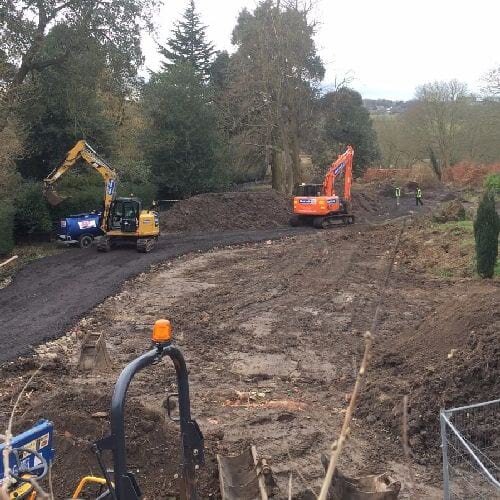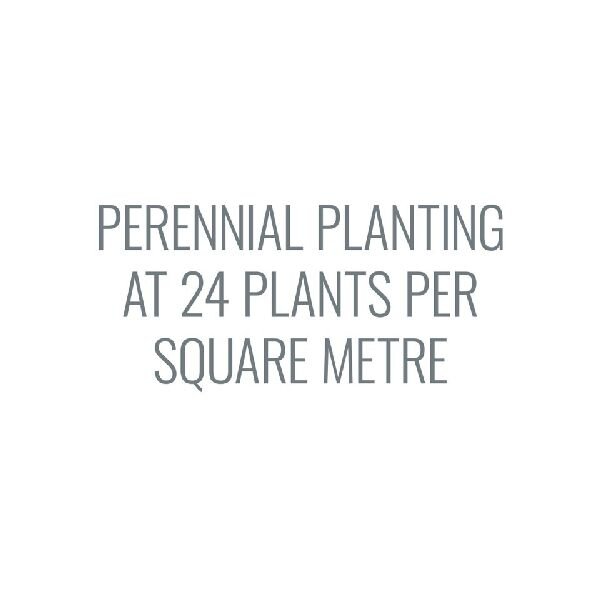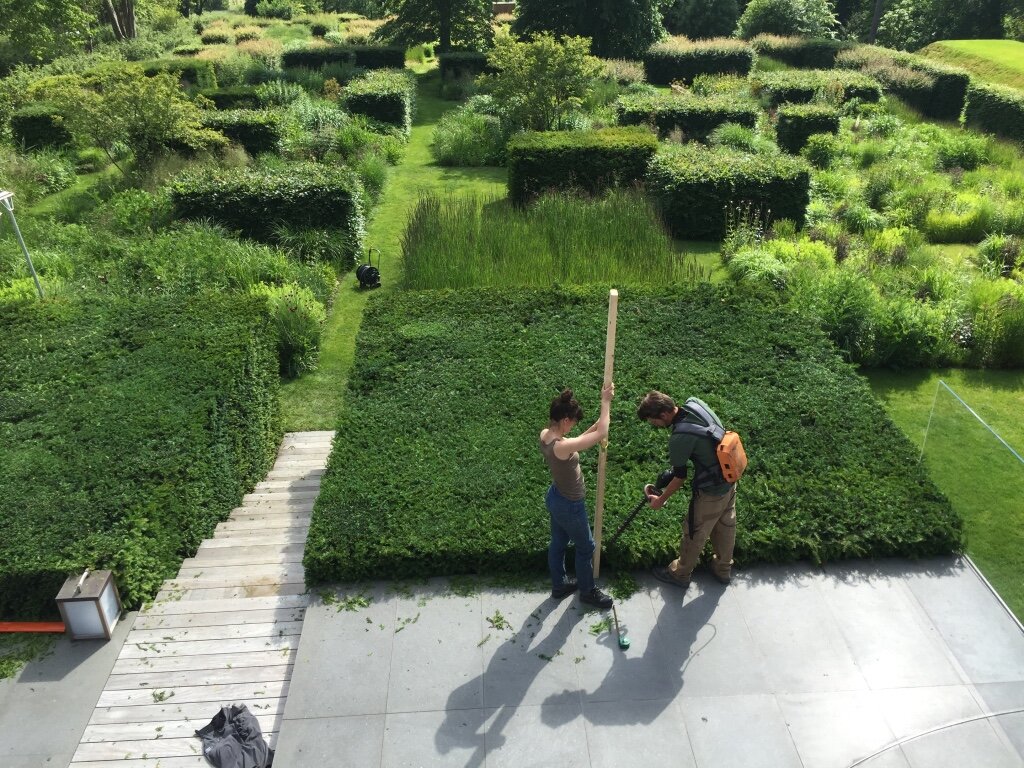Totteridge - an influential contemporary garden
Project Details
Architect: Robin Walker Architects
Landscape Designer: Christopher Bradley-Hole, BHSLA
Garden Installation Phase Two: Alaster Anderson
Project Management Phase Two: Alaster Anderson
Garden Maintenance: Alaster Anderson
The GARDEN
A Japanese-inspired garden over 7 ½ acres for a client in north London.
The Japanese influence is subtle not overt, as The Daily Telegraph has described: “What is Japanese here in Totteridge is the way the landscape beyond has been reinterpreted into a minimalist, abstract composition. In Japan, this might mean mountains and sea expressed as groups of weathered rocks in a swirling expanse of gravel. Here, it is the English field pattern that is captured: the hedges turned into a rhythmic sequence of short, free-standing blocks of clipped beech and yew, and the fields themselves into a chequerboard of small squares of grasses and perennials bisected by grass paths.”
Huge picture windows in the house give glorious views over this stunning garden, a project that was completed in two phases.
“A minimalist, abstract composition”
THE CHALLENGE
We were first appointed to take over the maintenance of a newly created six-acre garden. In a symbiotic collaboration, our key responsibility was to bring to life the vision of landscape designer Christopher Bradley-Hole. We achieved this through our trademark high-quality garden care and creative input into the development of hedging, meadows and perennial planting.
The client was very keen to have an entirely organic approach to the garden’s care and upkeep, and this passion for the environment was matched by his desire for a garden that would be fully mature within three to four years of planting.
While this work was underway, the client acquired the neighbouring 1 ½-acre property and we were invited to install this second phase of the garden. A two-year planning process presented a further obstacle, along with a very wet spring. Such complications however, only served to fire our energy and resolve!
“Immense scale and pioneering ideas”
OUR EXPERTISE
Totteridge offers many examples of how our expertise and artistry help lift a garden from the ordinary to the sublime in both phases.
Phase One
Phase One is a naturalistic interpretation of the English landscape where coppices of woodland are interspersed with meadows and pasture, with perennials, prairie-style grass and herbaceous planting. A harmonious effect was created from a combination of considered design and some irregular planting.
Highlights
To provide instant impact, perennials were planted at about 24 plants per square metre compared to the nine to 12 typically used. Although this is considered a very high planting density we found that the planting knitted together with individual species finding their own natural balance within the scheme. We did little to no staking and the primary work to the borders was undertaken in March when everything was cut back in advance of the new season and emerging bulbs were coming through. As a result the evolving planting looked good nearly all year round and perhaps looked at its best in autumn and winter when seed heads of Miscanthus created a rhythm repeated throughout the garden.
We are hugely excited with the Lonicera pileata Maygreen (box-leaved honeysuckle) hedging. When we started in the garden it was newly planted and we crafted it into something very sculptural with flowing contours of evergreen foliage. So successful was this that we repeated it on a larger scale in Phase Two. We provided a great deal of creative input into shaping both gardens’ hedges, a craft in itself that we have honed over many years as gardeners.
We also used impressive Calamagrostis Karl Foester grass which was planted in large blocks 3m square as well as in a length 180 metres long x 60cm wide to create a boundary between the two parts of the garden. The Calamagrostis was the first grass to flower and look good in the garden from June. It was incredibly weather resistant, even after heavy rain and snow, and continued to look amazing until it was cut back in March.
The grassland meadow with flowering plants was limited to bulbs of Narcissus and Camassia and for the rest of the summer airy grass seed heads. When we first took on the meadow it was stocked with too-tall, too-vigorous coarse grasses which fell over. Our solution to this challenge was over a number of years to lower the fertility of the soil, scarify and introduce Rhinanthus minor (yellow rattle) to encourage grasses with a shorter growing habit. We cut pathways through the meadow so the client can enjoy strolling through it whatever the season.
THE PROCESS IN NUMBERS
“As featured in the Telegraph”
Phase Two
Highlights
Our first role here was clearing the site, arranging for drainage and irrigation systems and bringing in fresh topsoil. A topographical engineer mapped the ground and laser pinpointed each planting bed. Getting the groundwork right is fundamental to the success of every project, and we could embark confidently on the planting.
We are very proud that only five species of plant were used throughout the whole of the 1 ½ acres, bringing wonderful, relaxing repetition to the landscape. This required working on a massive scale: we planted the equivalent of 10,000 hedging plants of Fagus sylvatica (common beech) in a grid system to create hedging blocks. These were interspersed with blocks of Calamagrostis Karl Foester grass.
A huge terrace was also created, edged by charred oak on three sides, to offer a stunning viewing platform and we commissioned a fabulous oak pergola that was built using traditional Japanese techniques. It is surrounded by giant Taxus baccata (yew) domes for greater sculptural effect.
In another area we used three multi-stemmed Parrotia persica (Persian Ironwood) weighing in at five tons each, underplanted with more Lonicera pileata Maygreen clipped into contouring mounds of evergreen foliage.
In a breath-taking flourish, the design allowed for an elaborate water feature by Andrew Ewing. The installation included a reflective pool with stone benches surrounded by beech hedging. The sitter can contemplate walking across … then do so by lowering the water at the touch of a button to reveal a stepping-stone path.
And in accordance with the client’s ecological brief, 100% of materials were composted and 100% of tools were battery operated. (Except for mowers!)
ONGOING MAINTENANCE
Despite its size, the garden is relatively easy to look after. We recruited and trained the Head Gardener who typically looks after much of the garden independently with extra resource brought in for the intense periods, particularly around March when much is cut back to ground level.
To find out more about this case study and other work in our portfolio please contact us.




















